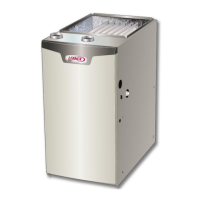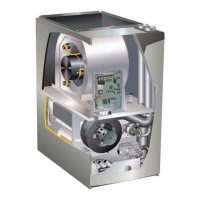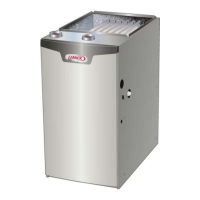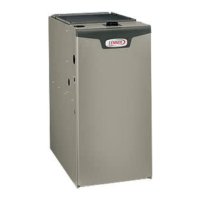Page 17
1 - In areas where piping penetrates joists or interior
walls, hole must be large enough to allow clearance
on all sides of pipe through center of hole using a
hanger.
2 - When furnace is installed in a residence where unit
is shut down for an extended period of time, such
as a vacation home, make provisions for draining
condensate collection trap and lines.
Removal of the Furnace from Common Vent
In the event that an existing furnace is removed from a
venting system commonly run with separate gas applianc-
es, the venting system is likely to be too large to properly
vent the remaining attached appliances. Conduct the fol-
lowing test while each appliance is operating and the oth-
er appliances (which are not operating) remain connected
to the common venting system. If the venting system has
been installed improperly, you must correct the system as
indicated in the general venting requirements section.
.
WARNING
CARBON MONOXIDE POISONING HAZARD
Failure to follow the steps outlined below for each
appliance connected to the venting system being placed
into operation could result in carbon monoxide poisoning
or death.
The following steps shall be followed for each appliance
connected to the venting system being placed into
operation, while all other appliances connected to the
venting system are not in operation:
1 - Seal any unused openings in the common venting
system.
2 - Inspect the venting system for proper size and
horizontal pitch. Determine that there is no blockage,
restriction, leakage, corrosion, or other deciencies
which could cause an unsafe condition.
3 - Close all building doors and windows and all
doors between the space in which the appliances
remaining connected to the common venting system
are located and other spaces of the building. Turn on
clothes dryers and any appliances not connected to
the common venting system. Turn on any exhaust
fans, such as range hoods and bathroom exhausts,
so they will operate at maximum speed. Do not
operate a summer exhaust fan. Close replace
dampers.
4 - Follow the lighting instructions. Turn on the appliance
that is being inspected. Adjust the thermostat so that
the appliance operates continuously.
5 - After the main burner has operated for 5 minutes,
test for leaks of ue gases at the draft hood relief
opening. Use the ame of a match or candle.
6 - After determining that each appliance connected to
the common venting system is venting properly, (step
3) return all doors, widows, exhaust fans, replace
dampers, and any other gas-burning appliances to
their previous mode of operation.
7 - If a venting problem is found during any of the
preceding tests, the common venting system must
be modied to correct the problem. Resize the
common venting system to the minimum vent pipe
size determined by using the appropriate tables in
Appendix G. (These are in the current standards of
the National Fuel Gas Code ANSI Z223.1.
Exhaust Piping (FIGURE 26 and FIGURE 27)
Route piping to outside of structure. Continue with instal-
lation following instructions given in piping termination
section.
WARNING
Carbon Monoxide Poisoning Hazard
Cutting or altering exhaust or air intake pipes, which
are located in the blower compartment, could result in
Carbon Monoxide Poisoning or Death.
CAUTION
Do not discharge exhaust into an existing stack or
stack that also serves another gas appliance. If vertical
discharge through an existing unused stack is required,
insert PVC pipe inside the stack until the end is even
with the top or outlet end of the metal stack.
CAUTION
The exhaust vent pipe operates under positive pressure
and must be completely sealed to prevent leakage of
combustion products into the living space.
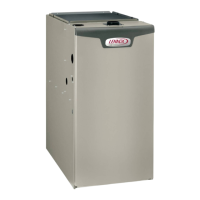
